Moniek Bloks's Blog, page 79
June 1, 2023
Princess Désirée at 85 – A Haga Princess
Princess Désirée of Sweden was born on 2 June 1938 as the third child and daughter of Gustaf Adolf, Duke of Västerbotten, and Princess Sibylla of Saxe-Coburg and Gotha.
Embed from Getty ImagesThe New York Times wrote upon Désirée’s birth, “Princess Sibylla, wife of Prince Gustaf Adolf, eldest son of the Crown Prince, tonight gave birth at Haga Castle to a daughter. Both are doing well. The Crown Prince tonight motored to Haga to greet the new member of the family. King Gustaf will do the same tomorrow and afterward will call a State Council to decide on a name for the Princess. As Princess Sibylla had already had two girls, a boy had been eagerly hoped for.”1 She was christened at Solna Church in Stockholm on 30 June 1938 and received the names Désirée Elisabeth Sibylla.
Embed from Getty ImagesShe had two elder sisters, Princess Margaretha and Princess Birgitta. In 1943, a younger sister named Princess Christina was born. At the time, Sweden still barred women from the throne. A younger brother, the future King Carl XVI Gustaf of Sweden, was born in 1946.
Désirée’s father tragically died in a plane crash in January 1947 while all the children were still very young. Her great-grandfather, King Gustaf V, reigned as King from 1907 until his death in 1950. He was succeeded by his son, King Gustaf VI Adolf. This meant that Désirée’s four-year-old brother became the Crown Prince. The three Princesses grew up at Haga Palace just outside Stockholm and thus became known as the Haga Princesses.
Désirée trained as a preschool teacher and also worked as a preschool teacher before her marriage. She also obtained a degree in textiles from the University College of Arts, Crafts and Design. Birgitta and Désirée made a ten-day visit to the United States in 1960, where they turned quite a few heads. Desirée charmed everyone when a little girl ran up to kiss her. The New York Times reported, “Too young to be awed, Meryl Schaffer rushed up to the tall brunette, arms outstretched for a kiss. Blushing prettily, Princess Désirée obliged. Meryl’s mother, who watched with some surprise, explained, ‘Ever since she got up this morning, she’s been saying, ‘I’m going to kiss a princess because it’s my birthday and I am 4 years old.'”2
In December 1963, the engagement between Princess Désirée and Baron Niclas Silfverschiöld was announced. The New York Times reported, “Princess Désirée, granddaughter of King Gustaf VI Adolf, became engaged today to Baron Niclas Silfverschiöld. The wedding will take place in Stockholm at the end of May. No date has been fixed. Princess Désirée is 25 years old; her fiance is 29. Princess Désirée is the daughter of Princess Sibylla and the late Prince Gustaf Adolf, who in an air crash in 1946(sic). She is the elder sister of the Swedish Crown Prince, Carl Gustaf. She now studies textile design here. Her fiance has a medieval castle and a farm in Southern Sweden called Koberg, which he operates.”[/note]New York Times[/note]
Embed from Getty ImagesEmbed from Getty ImagesThe couple was married on 5 June 1964 in Storkyrkan in Stockholm. As her groom was not royal, Princess Désirée lost her style of Her Royal Highness and was instead styled as Princess Désirée, Baroness Silfverschiöld. As she did not have any successions rights, she did not have any to lose. When absolute primogeniture was eventually introduced in 1980, the succession was limited to her brother’s descendants. Their first child, Carl, was born the following year. Christina-Louise was born in 1966, followed by Hélène in 1968. They made their home at Koberg Castle.
Embed from Getty ImagesHer brother married Silvia Sommerlath in 1976, and Princess Désirée was the godmother of their eldest child, Victoria, who became Crown Princess with the introduction of absolute primogeniture. Désirée is also one of Victoria’s names.
Embed from Getty ImagesPrincess Désirée sometimes attends the Nobel Prize ceremony and other family-related events. She was widowed in 2017. As she celebrates her 85th birthday, she has remained largely out of the public eye.
The post Princess Désirée at 85 – A Haga Princess appeared first on History of Royal Women.
A new Princess for Jordan!
A Royal Decree was issued to bestow the title of Her Royal Highness Princess Rajwa Al Hussein on Miss Rajwa Khalid Alseif on the occasion of her marriage to His Royal Highness Crown Prince Al Hussein.
Earlier today, the wedding ceremony, known as a “katb ktab”, took place at Zahran Palace with around 140 guests, including foreign royals. King Abdullah II and Queen Rania were on hand to greet the guests as they arrived. The bride arrived on the arm of her groom’s younger brother Prince Hashem.
She reportedly wore an Elie Saab dress and a new tiara.
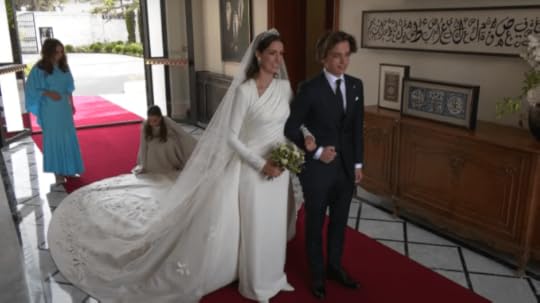 (Screenshot/Fair Use)
(Screenshot/Fair Use)After the ceremony, the Crown Prince and the new Princess greeted all the guests.
The newlyweds will now travel to the Al Husseiniya Palace as part of the Red Motorcade, which was traditionally a procession of white horses with riders dressed in blue trousers and red blazers. The motorcade and the riders will wear full Jordanian military regalia.
At Al Husseiniya Palace, the celebrations will continue with a Zaffeh, a musical procession. Then, through an honorary Arch of Sabers, the newlyweds will proceed through the courtyard towards the greeting stage. Here, they will be joined by both sets of parents to greet over 1,700 guests. The evening will feature several performances and will be concluded with the cutting of the wedding cake.
After the main reception, a wedding banquet will be held.
The post A new Princess for Jordan! appeared first on History of Royal Women.
May 30, 2023
Constance of Aragon, Queen of Hungary and Holy Roman Empress
Through her two marriages, Constance of Aragon gained a variety of royal titles – Queen of Hungary, Queen of Sicily, Queen of the Romans and Holy Roman Empress. By birth and her two marriages, she got to spend her life in several different countries – Spain, Hungary, Germany, and Italy.
Constance was born around 1179 in Lisbon, Portugal, to Alfonso II, King of Aragon and Sancha of Castile. She was the second oldest of her parent’s eight children and the oldest daughter. She seems to have been close to her next oldest sibling, her brother Alfonso, who was just one year younger than her. Constance’s father died in 1196, and her oldest brother, Peter, became King of Aragon as Peter II.
Queen of Hungary
Soon after her father’s death, Peter arranged for Constance to marry the new King of Hungary, Emeric. This was the first time a royal marriage was arranged between Hungary and a Spanish kingdom. Emeric wanted a closer connection with the kingdoms to the west, so the Pope, Innocent III, helped arrange this match. The marriage was celebrated in 1198. As a dower, Constance received the income of two royal counties in Hungary. If she were widowed, she would receive thirty thousand gold ounces.
In late 1199 or 1200, Constance gave birth to a son named Ladislaus. Little else is said about Constance’s brief time as Queen of Hungary. During this time, Emeric would have had his own problems with his brother, Andrew. Andrew wanted the crown for himself, and Emeric tried to solve this problem by making him Duke of Croatia and Dalmatia. This kept Andrew away from the Hungarian court for some time, but eventually, that proved not enough for him, and Emeric had to place him under arrest. In 1204, Emeric came down with a serious illness. Seeing death was near; he crowned his four-year-old son as Junior King in August. Emeric reconciled with Andrew, named him as regent, and had him promise that he would protect his son. Emeric died on 30 November 1204.
Being regent was not enough for Andrew. He wanted to be king himself and tried to disinherit or even kill his four-year-old nephew. Constance fled to Vienna, taking Ladislaus with her. She also took her dower money, twelve thousand silver marks. Constance and her son were given protection by Duke Leopold IV of Austria, her husband’s cousin. Unfortunately, things didn’t turn out well for Constance. Ladislaus died in May 1205, and Andrew became King of Hungary. With her son dead, Constance was left with no other option but to return to Aragon. There, she spent the next several years living with her mother at the convent of Sigena.
Queen of Sicily
Constance was still young and had an opportunity to remarry. In 1208, Peter once again negotiated with the Pope and had Constance betrothed to Frederick, the young King of Sicily. Constance was about fifteen years older than Frederick. In June 1209, Constance left Aragon with her brother, Alfonso and five hundred Aragonese knights. Constance and Frederick married on 15 August, Constance was about thirty, and Frederick was fourteen.
Wanting to make a claim on the imperial crown, Frederick planned an invasion of mainland Italy. Thanks to his new marriage, he could count on the knights who accompanied Constance. Unfortunately, before he could begin his campaign, an epidemic hit the company killing most of the knights and Alfonso. The remaining knights soon returned to Aragon.
Frederick seemed to rely on Constance. Early in their marriage, he replaced the chancellor due to Constance’s advice. Early in 1211, Constance gave birth to a son who was named Henry. Being from the Hohenstaufen dynasty and a son of a Holy Roman Emperor, Frederick had a strong claim to that title. In 1211, the German high nobility was growing tired of the behaviour of the current emperor, Otto. A faction of the nobility elected Frederick as their king with the Pope’s consent. In the spring of 1212, Frederick sailed to the mainland to begin his quest for the crown. Constance remained in Sicily, where she became regent. As the ruler of Sicily, she appeared on coinage. During this time, she issued a number of charters jointly in her and her son’s names.
Queen of the Romans
In December 1212, at the Cathedral of Mainz, Frederick was crowned as King of the Romans, the title that was the step to be crowned Holy Roman Emperor. However, not all were ready to recognise him as their king. When Otto was officially deposed in 1215, Frederick was crowned as King of the Romans again. With his position consolidated, Frederick could now summon his wife and son to Germany. Constance and Henry departed from Messina in July 1216 and reached Nuremberg in December.
As King of the Romans, Frederick had to travel through his empire frequently to assert his authority. Constance accompanied him on his travels.
Holy Roman Empress
In 1220, Frederick finally got the approval from the Pope to be crowned Holy Roman Emperor. In August of that year, Constance and Frederick headed to Rome. In November, they were crowned Emperor and Empress by Pope Honorius III. Constance’s former brother-in-law, Andrew, had tried to get the Pope to force Constance to cede her dower money to him. While in Rome, Constance told the Pope that she would refuse to do so. After the coronation, Constance, Frederick and Henry travelled through southern Italy before reaching Sicily.
In early 1222, Frederick left for mainland Italy. He took Henry with him so he could learn the art of statecraft. Constance stayed behind in Sicily. Due to a revolt in Sicily, Frederick returned in May, met with Constance, and left Henry with her. Unfortunately, this would be the last time they would see each other. Constance died in Catania, Sicily, on 23 June 1222, apparently from malaria. Two funerals were held for her; one in Catania and one in Palermo. Constance was buried in the Palermo Cathedral.
Constance was buried with many jewels benefiting her rank as Empress. She was interred in a sarcophagus from Roman times. Her body was wrapped in red cloth with pearls and gold foil. She was also buried with a breastplate, belt decorations, a jewelled collar and five rings. Most notably, her tomb contained a Byzantine-style crown.
Sources
Alio, Jacqueline; Queens of Sicily, 1061-1266
Mielke, Christopher; “No Country for old Women: Burial Practices and Patterns of Hungarian Queens of the Arpad Dynasty (975-1301)”
Mielke, Christopher; “From Her Head to Her Toes: Gender-Bending Regalia in the Tomb of Constance of Aragon, Queen of Hungary and Sicily”
The post Constance of Aragon, Queen of Hungary and Holy Roman Empress appeared first on History of Royal Women.
May 29, 2023
The Marienkirche in Wolfenbüttel
The Marienkirche or Hauptkirche Beatae Mariae Virginis in Wolfenbüttel, Germany, houses the remains of several members of the Brunswick-Wolfenbüttel family. They were Dukes of Brunswick-Lüneburg and Princes of Brunswick-Wolfenbüttel.
 Photo by Moniek Bloks
Photo by Moniek Bloks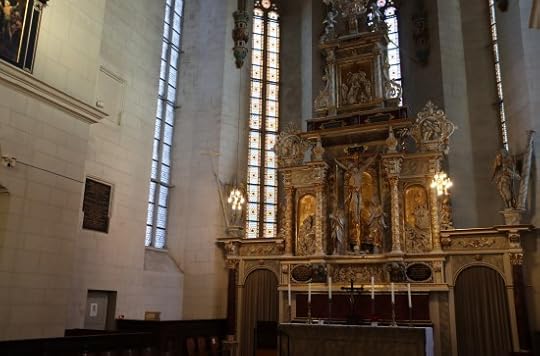 Photo by Moniek Bloks
Photo by Moniek BloksThe church was commissioned by Henry Julius, Duke of Brunswick-Lüneburg, in 1608 to replace a church that was built there in 1533. The 11 burials that took place during this time remain buried in the church, but these graves are not visible anymore.
These are:
Sophia Jagiellon 1522-1575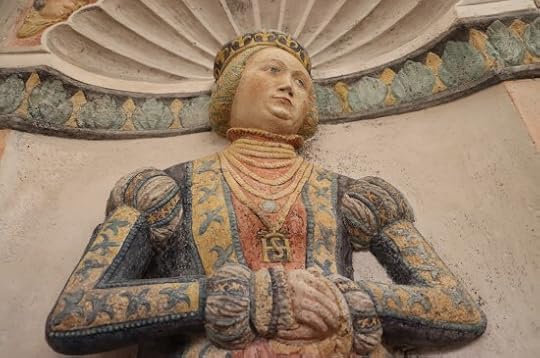 Photo by Moniek Bloks
Photo by Moniek Bloks
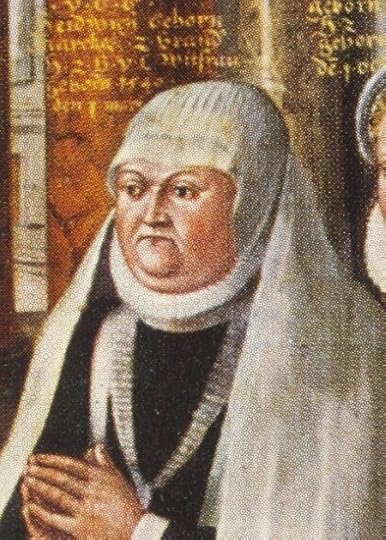 (public domain)
(public domain)
The new crypt that was built is open to the public. This crypt contains the following remains:
Henry Julius, Duke of Brunswick-Lüneburg 1564-1613Henry Charles of Brunswick-Lüneburg 1609-1615Julius Augustus of Brunswick-Lüneburg 1578-1617Dorothea Augusta of Brunswick-Lüneburg, 1577-1625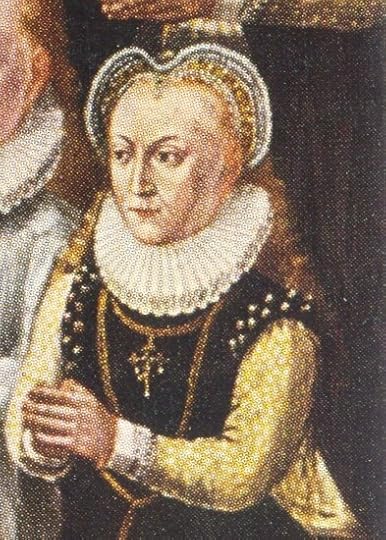 (public domain)
(public domain)
 (public domain)
(public domain)
 (public domain)
(public domain)
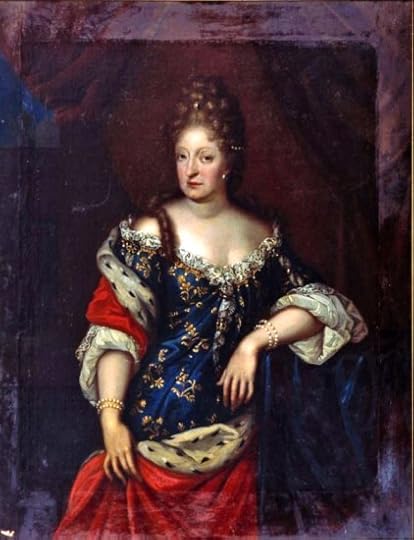 (public domain)
(public domain)
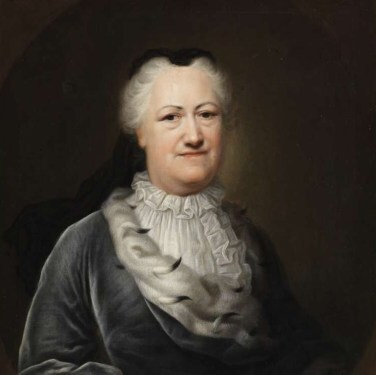 Click to view slideshow.
Click to view slideshow.The church is open to the public. Plan your visit here.
The post The Marienkirche in Wolfenbüttel appeared first on History of Royal Women.
May 28, 2023
Royal Wedding Recollections – Prince Maurits of Orange-Nassau & Marilène van den Broek
On 29 May 1998, Prince Maurits of Orange-Nassau married Marilène van den Broek in a civil ceremony. He is the eldest son of Princess Margriet of the Netherlands and Pieter van Vollenhoven.
The civil marriage took place in The Loo Palace and was performed by the mayor of Apeldoorn. For this ceremony, Marilène wore a red suit. Around sixty family members were present for the ceremony. However, then Queen Beatrix and her husband Prince Claus, were not there as they were in Portugal.
Embed from Getty ImagesMaurits’s brother Prince Bernhard and a friend named Jean-Paul Drabbe were his witnesses, while Marilène’s witnesses were her sister Caroline van Weele-van den Broek and her friend Emilie van Karnebeek.1
Their religious ceremony took place the following day in the Great Church of Apeldoorn, led by N.M.A. ter Linden and G.Th.Oostvogel. Marilène was led down the aisle by her father in a dress designed by Pierre Yves. The dress was made of Brussels lace and had a 4-metre-long train. She also wore the Dutch Ears of Wheat tiara, which originally existed as eight brooches.
Embed from Getty ImagesAfter the ceremony, the newlyweds went by carriage to the Loo Palace.
Embed from Getty ImagesThe Dutch parliament officially granted their permission for this wedding, which meant that Prince Maurits retained his place in the line of succession. He lost his place in the line of succession with the accession of King Willem-Alexander in 2013 due to his degree of kinship. By Royal Decree, it was decided that their children would carry the name “van Lippe-Biesterfeld van Vollenhoven.”2
Embed from Getty ImagesMarilène is referred to as Her Highness Princess Marilène of Orange-Nassau. The couple went on to have three children together: Anna (2001), Lucas (2002) and Felicia (2005).
Embed from Getty ImagesThe post Royal Wedding Recollections – Prince Maurits of Orange-Nassau & Marilène van den Broek appeared first on History of Royal Women.
May 26, 2023
Yoshiko Kawashima – Qing Dynasty Princess, Japanese spy, and female commander (Part two)
Princess Yoshiko Kawashima was one of China’s most enigmatic figures. She was a Qing Dynasty Princess, a Japanese spy, and a female commander. She has often been seen as a heroic figure or a traitor.[1] Despite her controversy, Princess Yoshiko Kawashima made a tremendous impact on Chinese history. In my last article, I discussed how Princess Yoshiko Kawashima played a role in restoring Emperor Puyi’s throne. In this article, I will discuss in detail her role as a spy and a female commander. I will also detail her tragic fate.
After she brought Empress Wanrong to Changchun, Princess Yoshiko Kawashima’s next mission was to create disturbances in Shanghai that would distract China from paying attention to the Japanese takeover of Manchuria.[2] In 1932, Princess Yoshiko Kawashima created a hate crime against the Japanese.[3] She hired workers at a towel factory in Shanghai to attack Japanese monks from the Japanese San Miyou Hou Ji Temple.[4] They killed one monk and injured three of them.[5] Princess Yoshiko Kawashima was then ordered to burn the towel factory that consisted of a thousand workers.[6] Many workers died and were critically injured.[7] After the incident, the Japanese Kwantung Army demanded the Shanghai mayor dissolve Japanese discrimination in Shanghai.[8] Afterwards, Princess Yoshiko Kawashima attended dance parties in Shanghai to get information that would help the Japanese Kwantung Army.[9] She also had a series of lovers.[10]
In 1933, Princess Yoshiko Kawashima became friends with Colonel Tada Hayao, the Commander of the Japanese Army in Northern China. She told him that instead of the Japanese having direct control of Manchuria, it would be better if the state would be controlled by the Manchus.[11] Colonel Tada was impressed with Princess Yoshiko Kawashima’s idea.[12] He found her to be courageous and beautiful.[13] He began to be attracted to her.[14] He would later become one of her long list of lovers.[15] He gave Yoshiko Kawashima her own army of three thousand troops, which was called the An Guo Army.[16] Yoshiko Kawashima began to be known as Commander Jin Binhui.[17] The fact that she was head of her army made her a sensation in Japanese headlines.[18]
In 1933, Yoshiko Kawashima was most famous for taking part in the Battle of Rehe (which took place between Fengtian and the northern border of China).[19] On 17 July, a soldier of the Japanese Kwantung Army had been kidnapped and killed by Chinese generals in the area.[20] The Japanese Kwantung Army retaliated by attacking the Chinese Army.[21] Princess Yoshiko Kawashima had no direct involvement in the battle.[22] Nevertheless, she became the poster girl of the Japanese Kwantung Army.[23] There is a photo of her on top of a horse and dressed in military uniform.[24] This image made an international sensation, and she was called the “Joan of Arc of the Orient.”[25]
Princess Yoshiko Kawashima kept reminding the Japanese Kwantung Army about her identity as a Qing Dynasty Princess.[26] It was not long that the top officers in the army began to be tired of her.[27] They decided to remove her presence in China.[28] In 1934, she was sent back to Japan. In Japan, she became a national celebrity.[29] Muramatsu Shofu wrote his bestselling novel, Beauty in a Man’s Attire, based on her.[30] She was invited to parties where she gave speeches and was often on the radio.[31] On 23 March 1937, she was the honoured guest at Matsumoto Girl’s High School, where she once went to school.[32]
In 1942, Princess Yoshiko Kawashima retired from the Japanese Kwantung Army and lived her life in solitude.[33] She stayed at a hotel in Tokyo and had a pet monkey.[34] Because she was a solitary figure, the Japanese Kwantung Army began to be suspicious of her.[35] They even planned to assassinate her.[36] Princess Yoshiko Kawashima moved to Beiping, China.
After the Japanese surrender of World War II, Princess Yoshiko Kawashima was arrested by the Chinese Army in 1945. On 15 October 1947, Princess Yoshiko Kawashima was put on trial for being a traitor to China.[37] She wore a white sweater and trousers.[38] During her trial, she remained calm.[39] She told them that she did not betray her country and that her goal had always been to restore the Qing dynasty.[40] She also said that she loved China but was a Japanese citizen.[41] On 22 October 1947, Princess Yoshiko Kawashima was given the death penalty. Princess Yoshiko Kawashima’s execution took place at 6:40 a.m. on 8 March 1948. Before her execution, Princess Yoshiko Kawashima wrote to Naniwa Kawashima in Japanese.[42] Then, she knelt down, and a single bullet was shot into the back of her head.[43] Princess Yoshiko Kawashima died instantly. She was forty-two years old.
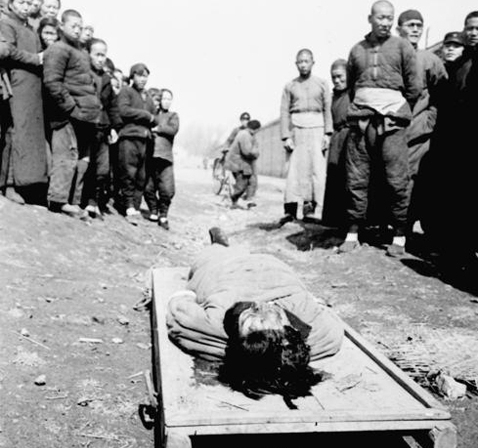 The body of Yoshiko Kawashima on display at Hopei Model Prison after her execution (public domain)
The body of Yoshiko Kawashima on display at Hopei Model Prison after her execution (public domain)At 7 a.m. on 8 March 1948, Princess Yoshiko Kawashima’s body was carried out of the rear gate of the prison.[44] Because of her traitor status, none of her siblings wanted to take her body to arrange her funeral.[45] Instead, they decided to distance themselves from her.[46] A Japanese Buddhist priest named Furukawa Taikou took Princess Yoshiko Kawashima’s body and cremated it at 1 p.m.[47] Then, he divided her ashes. He buried half of them in the crematorium cemetery.[48] He sent the other half to Naniwa Kawashima. Naniwa Kawashima later enshrined the other half of her ashes in Kurohime Mt, Unryu ji Temple.[49]
Princess Yoshiko Kawashima lived an unconventional life. She has become a popular icon. There have been many musicals, novels, films, and television shows about her. She has mostly been seen in a sympathetic light. She has been especially popular among Japanese women who view her as a tragic heroine.[50] Because Princess Yoshiko Kawashima lived on her own terms, she will continue to be a popular figure in the years to come.
Sources:
Birnbaum, P. (2015). Manchu Princess: Japanese Spy: The Story of Kawashima Yoshiko, the Cross-Dressing Spy who Commanded Her Own Army (Asia Perspectives: History, Society, Culture). NY: Columbia University Press.
Kawashima, Yoshiko (1906–1947) (Vol. 1). (2007). Gale. https://search.ebscohost.com/login.as....
Saeki, C. (2006). Yoshiko Kawashima: Politics and gender in Sino-japanese relations. Asian Journal of Women’s Studies, 12(3), 75-98,125-126. https://www.proquest.com/scholarly-jo....
[1] Birnbaum, 2015
[2] Kawashima, Yoshiko (1906–1947), 2007
[3] Saeki, 2006
[4] Saeki, 2006
[5] Saeki, 2006
[6] Saeki, 2006
[7] Saeki, 2006
[8] Saeki, 2006
[9] Birnbaum, 2015
[10] Kawashima, Yoshiko (1906–1947), 2007
[11] Saeki, 2006
[12] Saeki, 2006
[13] Saeki, 2006
[14] Saeki, 2006
[15] Saeki, 2006
[16] Birnbaum, 2015
[17] Birnbaum, 2015
[18] Saeki, 2006
[19] Saeki, 2006
[20] Saeki, 2006
[21] Saeki, 2006
[22] Saeki, 2006
[23] Saeki, 2006
[24] Saeki, 2006
[25] Saeki, 2006, para. 29
[26] Saeki, 2006
[27] Saeki, 2006
[28] Saeki, 2006
[29] Birnbaum, 2015
[30] Birnbaum, 2015
[31] Birnbaum, 2015
[32] Saeki, 2006
[33] Birnbaum, 2006
[34] Saeki, 2006
[35] Saeki, 2006
[36] Saeki, 2006
[37] Birnbaum, 2015
[38] Birnbaum, 2015
[39] Saeki, 2006
[40] Saeki, 2006
[41] Saeki, 2006
[42] Saeki, 2006
[43] Birnbaum, 2015
[44] Birnbaum, 2015
[45] Saeki, 2006
[46] Saeki, 2006
[47] Saeki, 2006
[48] Saeki, 2006
[49] Saeki, 2006
[50] Saeki, 2006
The post Yoshiko Kawashima – Qing Dynasty Princess, Japanese spy, and female commander (Part two) appeared first on History of Royal Women.
May 25, 2023
Yoshiko Kawashima – Qing Dynasty Princess, Japanese spy, and female commander (Part one)
Princess Yoshiko Kawashima was one of China’s most controversial and legendary figures. She has often been called the “Joan of Arc of the Orient” [1] or the “Mata Hari of East Asia.” [2] She has often been depicted as a femme fatale who leads men to their deaths.[3] She was a princess of the Qing dynasty, a Japanese spy, and a female commander of the Japanese army. She has inspired the imaginations of many by cross-dressing as a man and wearing a military uniform. It is no wonder why she became an international sensation. In an era when women had very few rights, Princess Yoshiko Kawashima made a tremendous impact on Chinese history. Because Yoshiko Kawashima had a very dramatic life, I have decided to write two articles about this illustrious princess. This article will detail the princess’s role in restoring Emperor Puyi’s throne.
On 24 May 1906, Princess Yoshiko Kawashima was born in Beijing. Her original name was Aisin-Gioro Xianwangyu.[4] She was the fourteenth daughter of Prince Su and his fourth concubine, Lady Janggiya. She was also a cousin of Emperor Puyi, the Last Emperor of China. When the Qing dynasty fell in 1912, Prince Su was so distraught that his dynasty was overthrown.[5] He began to plan for the restoration of the Qing dynasty.[6] He turned to a Japanese man named Naniwa Kawashima, who had a vested interest in restoring the dynasty.[7] The two planned for a new nation in Manchuria where the Qing dynasty would be restored.[8] The person who could make this plan come to fruition was Prince Su’s daughter, Princess Aisin-Gioro Xianwangyu.[9]
In 1912, the seven-year-old Princess Aisin-Gioro Xianwangyu was adopted by Naniwa Kawashima and was given the name of Yoshiko Kawashima. He took her to Japan, where he raised her as his own daughter.[10] He instilled in her a love for Manchuria and fostered her dreams of restoring the Qing dynasty.[11] Princess Yoshiko Kawashima went to Matsumoto Girl’s High School. However, she was an unruly student.[12] When her classmate was struggling financially, Princess Yoshiko Kawashima took a naked photo of herself and told her to sell it so that she could get some money.[13] In 1922, Prince Su died, and a month later, Lady Janggiya died. With the death of her parents, Princess Yoshiko Kawashima quit school and was tutored at home.[14]
With the death of her father, Princess Yoshiko Kawashima expected that Naniwa Kawashima would take the place of her father.[15] However, on 6 October 1924, Naniwa Kawashima raped her. [16] This incident left her traumatized. That night, she decided that she would no longer be a woman but a man.[17] The next day, she cut off her long hair and styled it like a man.[18] She hoped that by dressing like a man, Naniwa Kawashima would no longer be sexually attracted to her.[19]
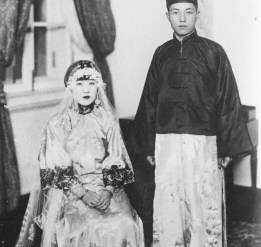 Wedding photo (public domain)
Wedding photo (public domain)During that time, Princess Yoshiko Kawashima had fallen madly in love with Toru Yamaga, a second lieutenant in the Japanese Kwantung Army.[20] While he liked her, he was never serious about her and did not propose to her.[21] In October 1927, she married the Mongolian prince, Ganjurjab. This was a political marriage arranged by Naniwa Kawashima. The goal of the marriage was to use Mongolia’s military force to take over Manchuria.[22] The marriage lasted three years. It ended with Princess Yoshiko Kawashima leaving him in Mongolia.[23] She moved to Shanghai, where she would become a Japanese spy.
In 1930, Princess Yoshiko Kawashima met Major Ryukichi Tanaka, head of the Japanese Intelligence Service in Shanghai. The two of them became lovers.[24] He trained Princess Yoshiko Kawashima to be a spy for the Japanese Kwantung Army.[25] Her first mission was to transfer Empress Wanrong from Tientsin to Changchun.[26] Princess Yoshiko Kawashima disguised herself as a man and drove Empress Wanrong and her dog to Changchun.[27]
Shortly after Empress Wanrong was reunited with her husband, Emperor Puyi became the head of the state of Manchukuo. Two years later, he would be crowned Emperor of Manchukuo. Throughout the Emperor’s coronation ceremony, Princess Yoshiko Kawashima wore an expression of excitement, for she had finally accomplished her father’s mission of restoring the Qing dynasty.[28] She wore a military uniform, riding boots, and a cap.[29] She would later recall that day as the happiest moment of her life because her dreams had finally been fulfilled.[30]
Princess Yoshiko Kawashima relentlessly pursued her dream of restoring the Qing Dynasty. She finally accomplished her father’s dream and restored Emperor Puyi to the throne. In my next article, I will detail Princess Yoshiko Kawashima’s role as a spy and a female commander. I will also discuss her tragic fate. Princess Yoshiko Kawashima was a controversial figure who defied the expectations of women in her era. It is no wonder she has become a popular icon that has continued fostering many people’s imaginations.
Part two coming soon.
Sources:
Birnbaum, P. (2015). Manchu Princess: Japanese Spy: The Story of Kawashima Yoshiko, the Cross-Dressing Spy who Commanded Her Own Army (Asia Perspectives: History, Society, Culture). NY: Columbia University Press.
Kawashima, Yoshiko (1906–1947) (Vol. 1). (2007). Gale. https://search.ebscohost.com/login.as....
Saeki, C. (2006). Yoshiko Kawashima: Politics and gender in sino-japanese relations. Asian Journal of Women’s Studies, 12(3), 75-98,125-126. https://www.proquest.com/scholarly-jo....
[1] Saeki, 2006, para. 1
[2] Saeki, 2006
[3] Birnbaum, 2015
[4] Kawashima, Yoshiko (1906–1947), 2007
[5] Birnbaum, 2015
[6] Birnbaum, 2015
[7] Birnbaum, 2015
[8] Saeki, 2006
[9] Saeki, 2006
[10] Kawashima, Yoshiko (1906–1947), 2007
[11] Saeki, 2006
[12] Saeki, 2006
[13] Saeki, 2006
[14] Saeki, 2006
[15] Saeki, 2006
[16] Saeki, 2006
[17] Saeki, 2006
[18] Saeki, 2006
[19] Saeki, 2006
[20] Birnbaum, 2015
[21] Saeki, 2006
[22] Saeki, 2006
[23] Birnbaum, 2015
[24] Kawashima, Yoshiko (1906–1947), 2007
[25] Saeki, 2006
[26] Saeki, 2006
[27] Saeki, 2006
[28] Saeki, 2006
[29] Saeki, 2006
[30] Saeki, 2006
The post Yoshiko Kawashima – Qing Dynasty Princess, Japanese spy, and female commander (Part one) appeared first on History of Royal Women.
May 24, 2023
Royal Wedding Recollections – A double royal wedding
On 25 May 1553, a double royal wedding took place. The young King Edward VI of England was dying, and although he had tried to leave the throne to Lady Jane’s male heirs, Lady Jane simply didn’t have enough time to produce one.
Lady Jane and her sisters Mary and Katherine were first cousins once removed of the King. Their grandmother was Mary Tudor, Queen of France and Duchess of Suffolk, the sister of King Henry VIII of England. King Edward had two living sisters (the future Queens Mary I and Elizabeth I), but Mary was a Catholic, and Elizabeth would probably not agree to supersede Mary, despite her concerns.1 Thus, he settled on the male heirs of his cousins, and they were dutifully quickly married off to produce the said male heir.
Lady Jane married Lord Guildford Dudley, while Katherine married Henry Herbert, Lord Herbert. The eight-year-old Mary was matched with the middle-aged Lord Grey of Wilton, although she was not old enough to be legally married.
The weddings took place at Durham, with the couples dressed in silver and gold. The fifteen-year-old Henry, Lord Herbert, had been dreadfully ill and looked it too. The King was too unwell to attend the ceremony but sent “presents of rich ornaments and jewels.”2 At the same time, one of Lord Guildford’s sisters, the twelve-year-old Catherine, was also married to Lord Hastings.
After the wedding, Lady Jane and her sister Lady Katherine moved to their new homes. Jane moved to Sion in Richmond, while Katherine moved to Baynard’s Castle. Jane, under the most pressure to produce, probably had her marriage consummated almost immediately.
Not much later, the King altered his succession plan to include Jane herself – he was running out of time. He died on 6 July 1553, with Jane briefly succeeding him until Mary successfully claimed the throne. Both Jane and Guildford were eventually executed. Katherine survived the upheaval, and her marriage to Henry, Lord Herbert, was annulled the following year.
The only marriage to survive from that day was that of Lady Catherine Dudley to Lord Hastings, later Earl of Huntingdon.
The post Royal Wedding Recollections – A double royal wedding appeared first on History of Royal Women.
May 23, 2023
Royal Wedding Recollections – Prince Joachim of Denmark & Marie Cavallier
On 24 May 2008, Prince Joachim of Denmark married the French-born Marie Cavallier.
It was his second marriage; the first to Alexandra Manley had ended in divorce in 2005. He had two sons from his first marriage.
The engagement between Joachim and Marie was announced on 3 October 2007. The official statement read, “Her Majesty the Queen of Denmark and His Royal Highness the Prince Consort are pleased to announce the engagement of their son, His Royal Highness Prince Joachim to Miss Marie Cavallier.” During a news conference, they revealed that Joachim had proposed to her during a vacation in Turkey.1
The wedding took place in Møgeltønder Church. Her white lace wedding dress was designed by the fashion house Arasa Morelli and made by a Danish woman. She wore a diamond floral tiara, loaned from her future mother-in-law, Queen Margrethe II.
Marie walked down the aisle with her father, Alain Cavallier, and Joachim walked down the aisle with his two sons from his previous marriage, Prince Nikolai and Prince Felix2, who were also his best men. Marie’s bridesmaid was her friend Agnete Windfelt Arno. The ceremony was performed by Bishop Erik Normann Svendsen.
Embed from Getty ImagesEmbed from Getty ImagesEmbed from Getty ImagesEmbed
Embed from Getty ImagesFollowing the church ceremony, the wedding banquet took place in Schackenborg Castle.
Upon marriage, Marie became Her Royal Highness Princess Marie of Denmark, Countess of Monpezat. She also converted to the Evangelical-Lutheran Church of Denmark and became a Danish citizen.
Embed from Getty ImagesMarie and Joachim have two children together, Henrik and Athena.
The post Royal Wedding Recollections – Prince Joachim of Denmark & Marie Cavallier appeared first on History of Royal Women.
May 21, 2023
Princess Yunying – The tragic and short life of Emperor Puyi’s sister
Princess Yunying was the younger sister of Puyi, the Last Emperor of China. She was the eldest and favourite daughter of Prince Zaifeng, the Prince of Chun. Because she was his favourite, Prince Zaifeng had grand dreams for her. She married Empress Wanrong’s younger brother, Gobulo Runliang. Her life came to a sudden end at the age of seventeen because of her family’s distrust of Western medical practices. Out of all of Emperor Puyi’s seven sisters, Princess Yunying had the shortest life.
In 1908, Princess Yunying was born in Beijing. She was the eldest daughter of Zaifeng, the Prince of Chun and the half-brother of Emperor Guangxu. Her mother was Gūwalgiya Youlan. She had two older brothers, two younger brothers, and six younger sisters. When she was born, the two-year-old Puyi (her older brother) became the new Emperor of China with their father as Regent.[1] While they were growing up, Princess Yunying and Emperor Puyi had a very close relationship.[2] Their relationship continued to deepen after she had married.[3]
Princess Yunying was Prince Zaifeng’s favourite because she was his eldest daughter.[4] Prince Zaifeng began to view her as a political pawn that would strengthen his status.[5] Therefore, he gave her the most attention of all his daughters.[6] Princess Yunying was given an education in the Confucian classics.[7] She was also said to be very virtuous, gentle, and had an elegant appearance.[8]
Prince Zaifeng began to look for a suitor that would bring him the most advantage. Prince Zaifeng decided that Gobulo Runliang, the eldest son of Rongyuan (the Minister of the Interior), would be the most suitable husband for his daughter.[9] Runliang was educated and came from one of the most prestigious clans of the Manchu Eight Banners.[10] Later in 1922, Runliang’s elder sister, Wanrong, would marry Emperor Puyi and become Empress of China.[11]
Princess Yunying married Gobulo Runliang. It is unclear whether their marriage was happy. Some scholars claim that Princess Yunying and Gobulo Runliang had different personalities, which made their marriage unhappy. They claimed he smoked and was a womanizer.[12] Other scholars believe that their marriage was blissful and affectionate.[13] What is clear is that the marriage was too short for the couple to produce children.
In 1925, Princess Yunying began to suffer from appendicitis. The Chinese medicines could not cure her. The only choice that was left to save her was surgery.[14] However, Prince Zaifeng was still fearful of foreign medical practices and refused surgery as an option.[15] Thus, Princess Yunying continued to suffer until she finally died a few days later.[16] She was seventeen years old.[17]
Princess Yunying’s short life came to such an abrupt end due to her father’s suspicions of foreign medical practices. All of the hopes that Prince Zaifeng had once had for his favourite daughter remained unfulfilled. Princess Yunying was intelligent and virtuous.[18] Yet, her life was the shortest out of Emperor Puyi’s sisters. Emperor Puyi would greatly mourn the loss of his closest childhood sibling.
Sources:
DayDayNews. (September 9, 2019). “Puyi had seven sisters. What was their fate after the death of Qing Dynasty?”. Retrieved on 12 November 2022 from https://daydaynews.cc/en/history/amp/....
iNews. (n.d.). “What happened to the seven sisters of the last emperor Puyi?” Retrieved on 12 November 2022 from https://inf.news/ne/history/6ba8b7d02....
iNews. (n.d.). “The seven sisters of the last emperor Puyi are all superb, but the ending is different.”. Retrieved on 12 November 2022 from https://inf.news/en/history/a63acf578e7646fa47708dcf6f6e263b.html.
Laitimes. (December 17, 2021). “The last emperor Puyi had seven younger sisters, and what was the final fate of these sisters?”. Retrieved on 12 November 2022 from https://www.laitimes.com/en/article/1....
[1] iNews, n.d., “The seven sisters of the last emperor Puyi are all superb, but the ending is different.”
[2] Laitimes, 17 December 2021, “The last emperor Puyi had seven younger sisters, and what was the final fate of these sisters?”
[3] Laitimes, 17 December 2021, “The last emperor Puyi had seven younger sisters, and what was the final fate of these sisters?”
[4] iNews, n.d., “The seven sisters of the last emperor Puyi are all superb, but the ending is different.”
[5] iNews, n.d., “The seven sisters of the last emperor Puyi are all superb, but the ending is different.”
[6] iNews, n.d., “The seven sisters of the last emperor Puyi are all superb, but the ending is different.”
[7] DayDayNews, 9 September 2019, “Puyi had seven sisters. What was their fate after the death of Qing Dynasty?”
[8] DayDayNews, 9 September 2019, “Puyi had seven sisters. What was their fate after the death of Qing Dynasty?”
[9] iNews, n.d., “The seven sisters of the last emperor Puyi are all superb, but the ending is different.”
[10] DayDayNews, 9 September 2019, “Puyi had seven sisters. What was their fate after the death of Qing Dynasty?”
[11] iNews, n.d., “The seven sisters of the last emperor Puyi are all superb, but the ending is different.”
[12] “iNews, n.d., “What happened to the seven sisters of the last emperor Puyi?”
[13] DayDayNews, 9 September 2019, “Puyi had seven sisters. What was their fate after the death of Qing Dynasty?”
[14] iNews, n.d., “The seven sisters of the last emperor Puyi are all superb, but the ending is different.”
[15] iNews, n.d., “The seven sisters of the last emperor Puyi are all superb, but the ending is different.”
[16] iNews, n.d., “The seven sisters of the last emperor Puyi are all superb, but the ending is different.”
[17] iNews, n.d., “The seven sisters of the last emperor Puyi are all superb, but the ending is different.”
[18] DayDayNews, 9 September 2019, “Puyi had seven sisters. What was their fate after the death of Qing Dynasty?”
The post Princess Yunying – The tragic and short life of Emperor Puyi’s sister appeared first on History of Royal Women.



